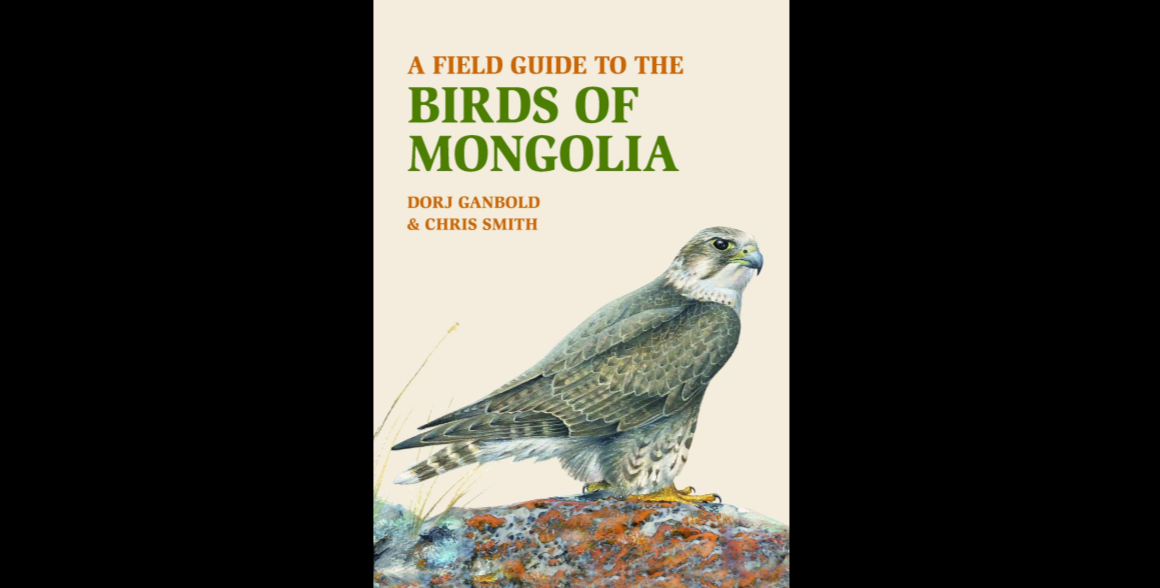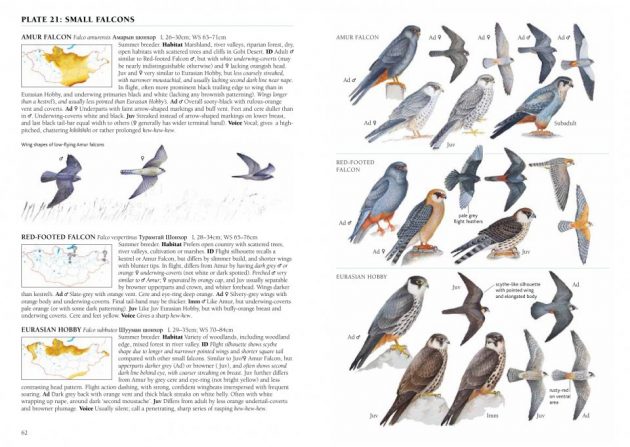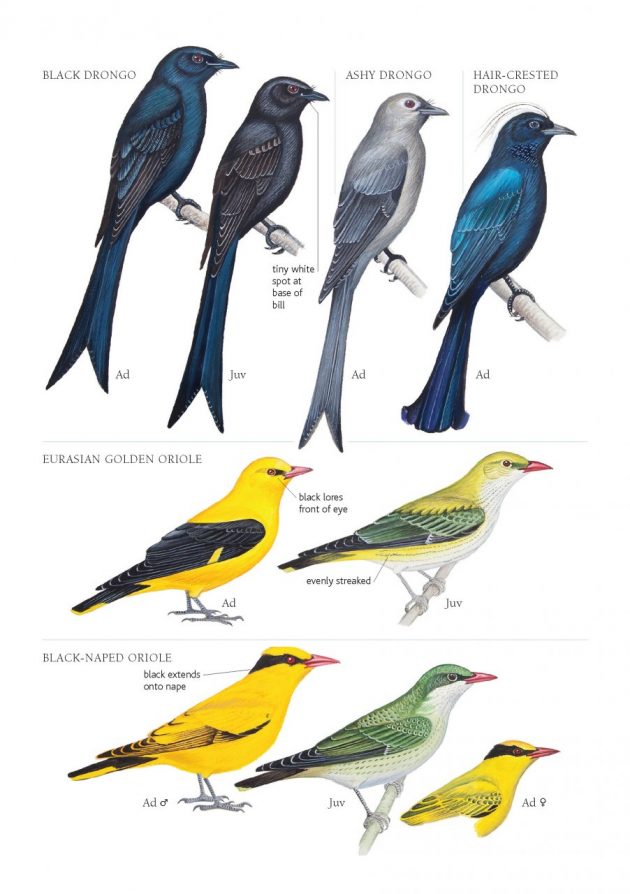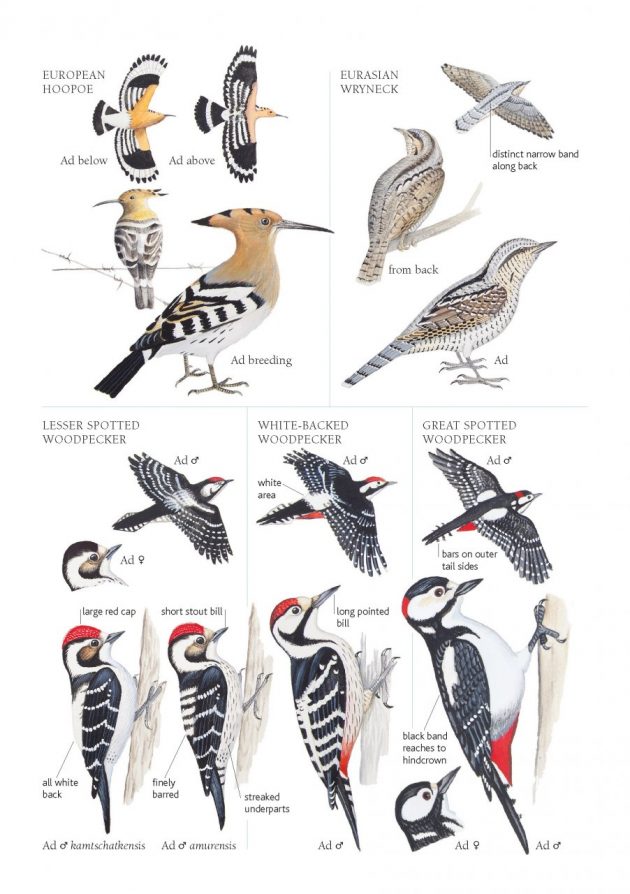
From its boreal forest to steppes which once trembled under the hooves of Genghis Khan’s hordes, and from the Gobi Desert to the Altai Mountains, Mongolia is still wild, sparsely populated country where you may consider searching for Altai Snowcock, Demoiselle and White-naped Cranes, Pallas’s Fish Eagle, Oriental Plover, Relict Gull, Pallas’s Sandgrouse or the Henderson’s Ground Jay.
A Field Guide to the Birds of Mongolia by Dorj Ganbold and Chris Smith (2019) offers more than 500 species in one neat edition. I say “more than” because I am not certain what number of species is covered: on page 8, 512 bird species are mentioned, while on the back cover that number rises to 521.
Dorj Ganbold is an ornithologist and professional illustrator. While at the National University of Mongolia, he conducted research on illustrating birds in the field, including at bird-ringing stations. He has served as a field ornithologist and expert on a number of research projects including Birds of the World and Migratory Birds of Prey.
After earning his Masters in wildlife conservation from Humboldt State University, Chris Smith spent four years travelling the globe doing bird field work on five continents. He has published numerous scientific papers on bird biology, and currently teaches for Round River Conservation Studies. Chris has spent several years conducting bird research in Mongolia, including with the Saker Falcon project.

Published by John Beaufoy Publishing, their field guide follows the user-friendly standard of illustrations on the right, and the range maps and descriptions on the left hand page. The species are illustrated in 154 plates, showing the local subspecies, plumage variation between sexes, seasons and age classes, as well as the upper side and underside of birds in flight. Common, scientific and Mongolian names are given for each species.
Many countries with underdeveloped birding scene cannot hope to ever see a bird guide in a local language (it would simply end up being too expensive) and I particularly respect the addition of the Mongolian names, making this edition useful for the locals who may be interested in their wildlife, but often do not speak English.
The introductory chapters include information on the geography and major habitats (illustrated with 12 colour photos).
Multi-colour range maps indicate the seasonal occurrence of each species. Rather large for a field guide, the maps have different shades, the stronger colour indicating the higher densities of birds (oh how I wish to see that in the Collins Bird Guide for Europe).
The text covers habitat, voice and the main identifying features, noticing differences between ages, sexes and subspecies, and focusing on separating species from similar ones. In general, for easier to ID species, textual descriptions are quite concise (around 150 words), but they do become longer when dealing with LBJs.

The illustrations are generally accurate and of high quality, include lots of birds in flight, and the plates are well organised. Another plus are the Peterson-style arrows pointing to the main ID features. I particularly like the large falcons and the two-page spread giving you a chance for easier comparisons.
Here treated as a subspecies Falco cherrug altaicus, the Altai Saker Falcon got a separate entry from the Falco cherrug. The text says: “Taxonomic position poorly studied, currently listed as a race of F. cherrug milvipes or hybrid between F. cherrug x F. rusticollis.” Yet, my friend, a Hungarian Saker expert Matthias Prommer commented (pers. comm.): “I wish they skipped the Altai Saker Falcon part. There is no such thing, we have the DNA proof. It is just a colour variation, not even local. Our [still unpublished] DNA study confirms that Altai type is only a colour morph, as their DNA samples scatter evenly within the ‘normal’ saker DNA samples, they do not form separate group.”
Other subspecies do not get a separate entry, but are depicted in the species main entry, together with a short textual description of the race.

There’s an issue with spotted woodpeckers: the comparative sizes are wrong. The White-backed Woodpecker should be noticeably bigger than the Great Spotted, which is here depicted as the largest of the three, while the Lesser Spotted should be much smaller than both.
In some cases the colours are odd, e.g. on the plate depicting Long-eared and the Short-eared Owls: in flight they somehow become greenish. And at the opposite end of the spectrum, Yellow-browed Warbler lacks its greenish tone. The European Greenfinch, together with the Eurasian Siskin below it, looks weird, especially the bright shade of green depicted on birds in flight. Some plates are definitely off-colour and green was the troublesome colour. Still, I comment here on issues with 4 out of 154 plates. Such off-colour plates are the exception and not the rule, and I am happy with the rest of them.
From rather large multi-colour range maps to concise descriptions and accurate illustrations, John Beaufoy’s Birds of Mongolia by Dorj Ganbold and Chris Smith will tell you where to look for Altai Snowcock and how to separate pallasi and lydiae races of the Pallas’s Bunting, or stejnegeri and maurus races of the Siberian Stonechat, and I’d really love to test it in the field. Overall, this is one good field guide.
A Field Guide to the Birds of Mongolia
By Dorj Ganbold and Chris Smith
• 210 x 148 mm (8¼ x 6”) • 304 pages • c.154 full colour plates, 521 distribution maps
• ISBN 978-1-912081-04-2 • £29.99 paperback • Publication October 2019
Publisher: John Beaufoy Publishing













Sounds like a good birding destination, especially because it is close to Serbia and the travel wouldn’t be too expensive.
I looked through some Mongolian species on eBird and there are quite a few exotic looking ones. Thanks for sharing!
Pozdrav iz Novog Sada! 🙂
Yep, you can always catch a ride on the trans-Siberian railway.
But most readers are from the USA, which is much closer. E.g. Serbia to Mongolia 8000 km / 5000 mi, but Mongolia to Alaska is only 5000 km / 3000 mi.
That’s true! But I think flights to Mongolia aren’t too expensive because it usually isn’t a popular tourist location. Although, I might be mistaken.
Is this book available in Mongolia? Where can it be found? I would like to pick up one on Monday.
I don’t know, it might be, check with the John Beaufoy Publishing.